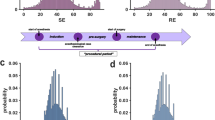Abstract
With age regular changes take place in the latent periods of spikes of the slow auditory evoked potential. In particular, the latencies of the comparatively early waves (P1, N1, and P2) become progressively shortened. Between 3–7 and 8–13 years the decrease is 50–60 msec, and later it is 25–35 msec. The latencies of the latest waves, especially P3, N3, and P4, increase from 3–7 to 8–13 years by 35–65 msec. Later the latent period of the P3 spike remains unchanged but the N3 and P4 waves disappear completely. Of all the components of the slow auditory evoked potential the most stable is the N2 wave, the latent period of which decreases only very slightly with age. In children aged 3–7 years two wave complexes (P1N1P2 and P2N2P3) overlap frequently to form a single undifferentiated wave. This splits up into its components by 8 years of age. Long age changes in the shape and parameters of the slow auditory evoked potential are examined from the standpoint of the predominantly extralemniscal origin of this potential. On the basis of correlation discovered between the late waves of the evoked potential and the level of EEG synchronization it is postulated that the late waves of the slow evoked potential are formed with the participation of the nonspecific synchronizing system.
Similar content being viewed by others
Literature cited
Z. Sh. Kevanishvili, B. Freygang, H. von Specht, H. Pantew, O. A. Khachidze, V. S. Afonchenko, and B. V. Chkhartishvili, "Slow auditory evoked potentials in man," Abstracts of Proceedings of Symposia of the 12th Congress of the All-Union Physiological Society [in Russian], Vol. 1, Nauka, Leningrad (1975), pp. 282–283.
B. V. Chkhartishvili and Z. Sh. Kevanishvili, "On an age-link feature of the auditory evoked potential in man," Soobshch. Akad. Nauk Gruz. SSR,79, 449 (1975).
O. D. Creutzfeldt and U. Kuhnt, "The visual evoked potential: physiological, developmental, and clinical aspects," Electroenceph. Clin. Neurophysiol., Suppl.26, 29 (1967).
H. Davis and S. Onishi, "Maturation of the auditory evoked potentials," Int. Audiol.,7, 413 (1968).
R. J. Ellingson, T. Danahy, B. Nelson, and G. H. Lathrop, "Variability of auditory evoked potentials in human newborns," Electroenceph. Clin. Neurophysiol.,36, 155 (1974).
G. Guilbaud, "Essai de classification des structures centrales au moyen des variations d'amplitude de leurs cycles veille-sommeil," Electroenceph. Clin. Neurophysiol.,28, 340 (1970).
J. Hassmanova and J. Mysliveček, "Maturation of the primary cortical response to stimulation of medial geniculate body," Electroenceph. Clin. Neurophysiol.,22, 547 (1967).
S. N. Khechinashvili and Z. Sh. Kevanishvili, "Experiences in computer audiometry (ECoG and ERA)," Audiology,13, 391 (1974).
A. Mathis and K. Graf, "Die elektrische Reaktionsaudiometrie (ERA) beim Neugebornen," Arch. Klin. Exp. Ohr.-, Nas.-Kehlk. Heilk.,201, 231 (1972).
T. W. Picton, S. A. Hillyard, H. I. Krausz, and R. Galambos, "Human auditory evoked potentials. I. Evaluation of components," Electroenceph. Clin. Neurophysiol.,36, 179 (1974).
D. Regan, Evoked Potentials in Psychology, Sensory Physiology and Clinical Medicine, Chapman and Hall, London (1971).
G. A. W. Sharrard, "Evoked response audiometry in comparing groups of normally hearing adults, normally hearing and deaf children and multiple-handicapped children," Electroenceph. Clin. Neurophysiol.,31, 366 (1971).
P. E. Tanguay, E. M. Ornitz, A. B. Forsythe, J. C. M. Lee, and D. Hartman, "Basic rest-activity cycle rhythms in the human auditory evoked response," Electroenceph. Clin. Neurophysiol.,34, 593 (1973).
E. D. Weitzman and H. Kremen, "Auditory evoked response during different stages of speech in man," Electroenceph. Clin. Neurophysiol.,18, 65 (1965).
H. L. Williams, D. I. Tepas, and H. C. Morlock, "Evoked responses to clicks and electroencephalo-graphic stages of sleep in man," Science,138, 685 (1962).
P. I. Yakovlev, "Morphological criteria of growth and maturation of the nervous system in man," Res. Publ. Assoc. Nerv. Ment. Dis.,39, 3 (1962).
N. Yamaguchi, C. M. Ling, and T. J. Marczynski, "Recruiting responses observed during wakefulness and sleep in unanesthetized chronic cats," Electroenceph. Clin. Neurophysiol.,17, 246 (1964).
Author information
Authors and Affiliations
Additional information
Tbilisi State Postgraduate Medical Institute. Translated from Neirofiziologiya, Vol. 9, No. 1, pp. 3–10, January–February, 1977.
Rights and permissions
About this article
Cite this article
Kevanishvili, Z.S., von Specht, H., Chkhartishvili, B.V. et al. Age changes in latent periods of the human slow auditory evoked potential. Neurophysiology 9, 1–7 (1977). https://doi.org/10.1007/BF01063536
Received:
Issue Date:
DOI: https://doi.org/10.1007/BF01063536




